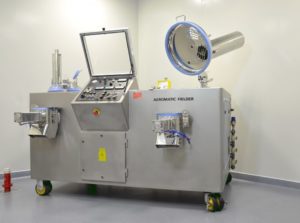 Pharmaceutical mixers blenders belong to the category of universal machines and can be used in several industrial sectors. We come across mixers and homogenizers in the pharmaceutical industry, chemical and cosmetics sector, as well as the food industry.
Pharmaceutical mixers blenders belong to the category of universal machines and can be used in several industrial sectors. We come across mixers and homogenizers in the pharmaceutical industry, chemical and cosmetics sector, as well as the food industry.
Homogenizers and blenders can be quite complex machines which also affects the price, making this piece of pharmaceutical machinery rather expensive. The price, naturally, depends on the complexity of use.
Mixers / Homogenizers
Mixers/homogenizers or mixing machines are used for mixing liquid solutions or in the case of cosmetics sector – creams. The mixing process and dispersion of several components into a homogeneous solution are maintained through a combination of pressurization, shearing and heat/cold, among other things.
The end result of the mixing process is a homogeneous substance, which can be an ointment, cream or lotion.
Mixers have a straightforward design: the machine is equipped with a tank, agitators and in most cases a control panel. Homogenizer can be added to the mixing machine as an extension. Among the main principles of homogenizers, usability is a sudden acceleration through a very narrow orifice in the particles.
Sudden impact against a flat surface helps to decompose the tiniest particles and homogenize the solution – liquid or cream. Regular maintenance is required to keep mixers/homogenizers in working condition and to assure compliance with quality standards.
Mass Mixers
Mass mixers are considered a special category of pharmaceutical machinery. They are used for thorough mixing of wet as well as dry material and are especially appropriate for tablet granulation. Speaking of the mass mixer design, it has a mixing stirrer in the horizontal position inside of the tank or bowl.
The rotation of the stirrer is simple, single speed. Slow speed rotation acquires thorough mixing of dry or wet ingredients and is extremely suitable for the pharmaceutical sector. Mixing of chemicals, food materials or powder can be performed with a mass mixer.
Mixers / Blenders
Types of Blenders
- Octagonal Blender. Octagonal Blender is used for efficient mixing of dry ingredients and granules. Among octagonal blender areas of use belong food, chemical, pharmaceutical, and cosmetic industry. As the name suggests, the body of this blender is of octagonal shape equipped with baffles for fast and efficient mixing. Octagonal blenders are a perfect match for the pharmaceutical industry where the gentle blending of dry ingredients /powder needs to be done.
- V-type Blenders. V type blenders are widely used in pharmaceutical and chemical industry. The blade of the blender rotates from the V position, this way the material is divided between right and left legs of the blender. As the rotation continues, ingredients blend and recombine. V blenders are mostly suitable for paints, dyes, and medications.
- Double Cone Blender. Two-thirds of the volume of the cone blender is filled to ensure proper mixing. This type of blenders is mainly used for the production of food, chemicals, pharmaceuticals, and cosmetic products. In the pharmaceutical sector, these machines are used to blend medicated powders. It is also the best way to mix very heavy and abrasive products for total discharge of product with minimal retention. Blender features multi shear deflector plates for the improved blending efficiency of free-flowing powders and dry ingredients.
Attributes of Pharmaceutical Mixers Blenders
These machines represent an unavoidable stage of the production process. They can also be used in a laboratory or during the development and validation stage of a product.
Mixing machines operate on 6 parameters:
- Substance of the product
- Capacity in L
- Stainless steel type
- Speed of the agitator in rpm
- Motor Power of the agitator in kW
- Double jacketed
Area of Use
Overall, this machine is mainly used in the cosmetic, chemical and pharmaceutical industries, as well as the food sector. Our online catalog features over 250 mixers/homogenizers from the best manufacturers as well as over 90 blenders.
Main Manufacturers
Exapro online catalog represents some of the highest rated international manufacturers in the pharmaceutical industry such as Fryma mixers/homogenizers, Guedu mixers/homogenizers, Krieger mixers/homogenizers, Amixon blenders, Imitrex blenders and many more. You can find these used machines online on Exapro. To simplify your search, use the system of filters and filter machines by the manufacturer, year of production, location or technical specification.
Thank you for reading our articles, stay informed about the industrial world and Exapro by following us on Exapro Hub, Facebook, Twitter, and LinkedIn.




It makes sense that homogenizers and blends can be complex. The fact that both are similar, but the uses for each are different probably makes it easy to confuse them. However, I imagine that’s not a problem as long as you aware of what ingredients that will be mixed.